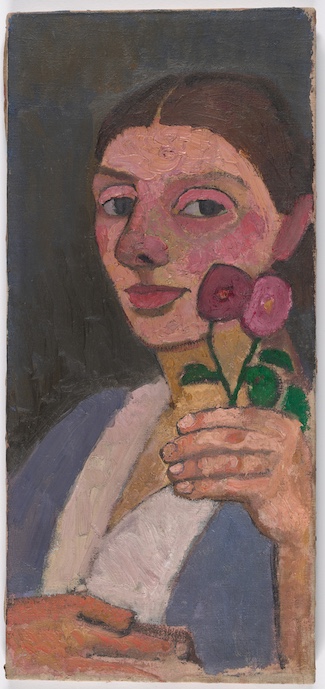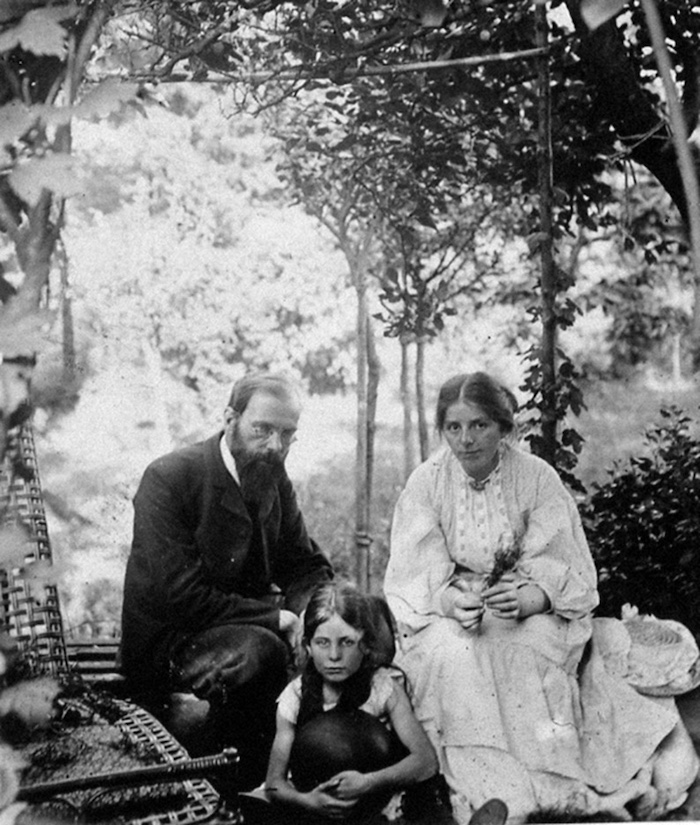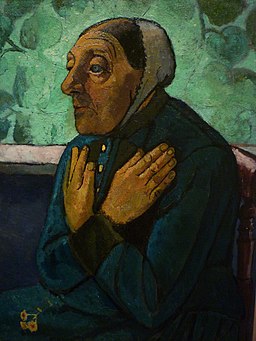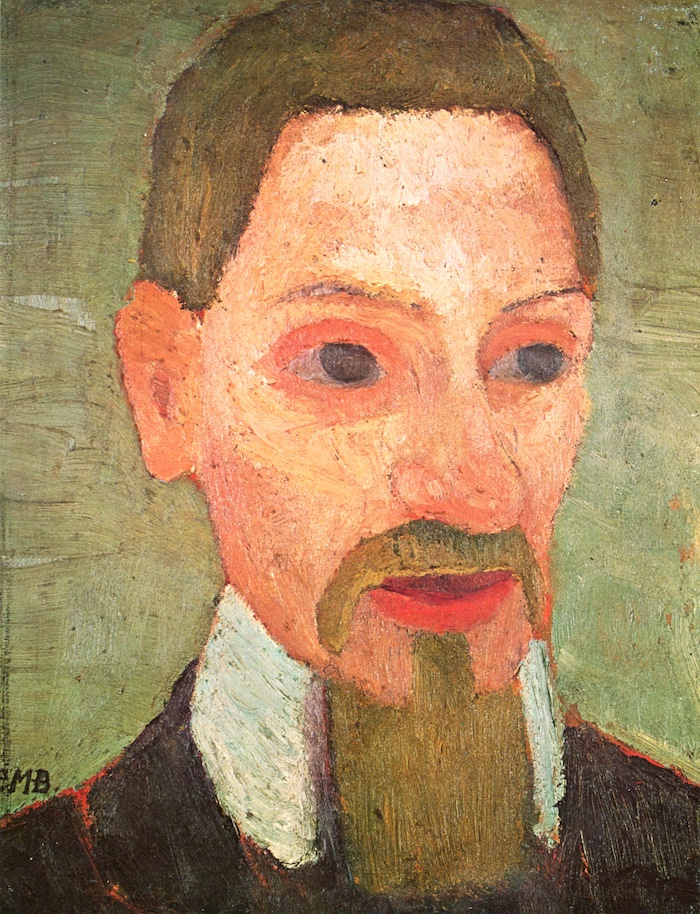
Paula Modersohn-Becker Self-Portrait with Two Flowers in Her Raised Left Hand 1907, collection MoMA, NYC
The intensity with which a subject is grasped – that is what makes for beauty in art.
–Paula Modersohn-Becker
The artist Paula Modersohn-Becker (1876–1907) a pioneering modern artist will be the subject of a long overdue retrospective ICH BIN ICH / I AM ME opening at the Neue Galerie in New York City June 6 through September 9, 2024. The exhibition is the first collabortion between Neue Galerie and the Art Institute of Chicago where the exhibition will be seen Oct 12, 2024–Jan 12, 2025.
In her career of only fifteen years, Modersohn-Becker produced more than 700 paintings and over 1,000 drawings and although nearly invisible to the public eye for many years, she is seen now as a transformative and significant figure of modern art. Her death from thrombosis just eighteen days after giving birth to her daughter Mathilde brought a tragic end to her outpouring of creativity.
Modersohn-Becker was born in Dresden, Germany in 1876, and moved to Bremen with her family in 1888. She studied in London and Berlin, and beginning in 1900, made multiple trips to Paris finding inspiration from Cézanne, Gauguin, van Gogh, Rousseau, and Egyptian art seen at the Louvre. Modersohn-Becker settled into an artists’ colony at Worpswede just outside Bremen, where she developed close friendships with the poet Rainer Maria Rilke, sculptor Clara Westhoff and met her future husband, painter Otto Modersohn. Hillary Reder, Curatorial Assistant, Department of Drawings and Prints at MOMA wrote this about Modersohn-Becker:
By 1906 she had begun painting life-sized nudes, measuring herself against the leading figures of the Parisian art world at the time, Pablo Picasso and Henri Matisse. While she rejected their overtly erotized depictions, like them, she sought to reinvent the representation of women in Western art history. Her most radical step was in taking herself as a subject, likely becoming the first modern woman artist to have painted nude self-portraits, and to have painted herself pregnant.
Several books have featured the art and life of Paula Modersohn-Becker. One of the best is the short experimental novel Being Here is Everything (MIT Press, 2015) by Marie Darrieussecq, a compact narrative told in the voice of the artist. Publisher’s Weekly called the writing style, “Poetic and stylized; the tableau unfolds sometimes in one-sentence paragraphs and one-word sentences, and always in the present tense. Clearly written for a broad audience, this book will renew appreciation for a deserving artist who’s too often reduced to a mere passing mention in art-history textbooks.”
Poet and novelist Sue Hubbard’s second novel of 2012 was the imaginative and detailed Girl in White reprinted by Pushkin Press in 2022. Girl in White tells the story of Modersohn-Becker through alternating chapters written in the voices of Paula’s grown daughter Mathilde and Paula. The book is a fine introduction to the artist and is based upon primary artist documents and the author’s own research beginning in the late 1990s. Girl in White is the Book Beat reading group selection for June 2024.
Dear Friend by poet Eric Torgersen (Northwestern University Press 1998) looks at the extrordinary seven-year relationship between Rainer Maria Rilke and Paula Modersohn-Becker told through their own correspondence, journals and Rilke’s poetry with many of the documents being translated here for the first time.
The exhibition catalog Paula Modersohn-Becker (Prestel, 2024) was produced for the first museum exhibition of Modersohn-Becker’s work in the United States. “It reveals the deeply personal and authentic work of an artist who resolutely forged her own path.” [publisher’s quote] The exhibitions will be held at the Neue Galerie and the Art Institute of Chicago, with catalogs available to the public in early July.
Paula Modersohn-Becker: A Life in Art by Uwe M. Schneede (Thames and Hudsons 2023) is a monograph with many rarely seen sketches and drawings taken from the Modersohn-Becker archive. “Schneede focuses in particular on her time in Paris, where she absorbed the luminous palette and expressive brushwork of the French avant-garde, and which so strongly impacted her ambitions and artistic trajectory. Schneede’s lively narrative is supported by some 120 illustrations, and peppered throughout with quotations from Modersohn’s letters and diaries.” [quote from publisher’s website]
Paula Modersohn-Becker: The First Modern Woman Artist by Diane Radyci (Yale, 2013) “Makes a convincing case for seeing Paula Modersohn-Becker as the first modern woman artist. . . . Readers of this monograph therefore should be anyone interested in modern art, women artists, the profoundly new art of Modersohn-Becker, and the heady ferment of the times in which she lived and worked.”–Art New England
Diane Radyci also authored the One-on-One series Paula Modersohn-Becker Self Portrait (2018 MoMA) a short essay that points out the influence of 2nd century C.E. Fayum mummy encaustic portraits from Roman Egypt that Modersohn-Becker observed in the Louvre. Radyci also connects a link to Picasso through Modersohn-Becker’s neighbor during her time in Paris, the “darling of the avant-garde” naïve painter Henri Rousseau, whose ornate floral backgrounds began turning up in Modersohn-Becker’s work. Radyci theorizes that Picasso had seen her mask-like portrait work and striking full sized nudes before his breakthrough portrait in 1906 of Gertrude Stein was finished.
A New Yorker interview with author/historian Diane Radyci describes how Modersohn-Becker was in the vacinity of Picasso and Matisse in 1906 Paris: Paula Modersohn-Becker: Modern Painting’s Missing Piece

Otto Modersohn his daughter Elizbeth and Paula Modersohn-Becker in Worpswede (1904), Photo by Martha Vogeler, Paula Modersohn-Bexker Stiftung, Bremen
A series of self-portraits taken at the Paula Modersohn-Becker museum are found at Nasty Women Writers; Theresa C. Dintino the author of the webpage, describes her encounter with the artwork, “The paintings are alive and stunning. They are a conversation, an intimate experience with the mind and psyche of the artist… I was intrigued by the very large hands in many of these self-portraits… I feel they are symbols of power. The power of the hands of a woman. The power of Paula’s hands as she created these images.”
5 Works to Know by Paula Modersohn-Becker, the ‘First Modern Woman Artist’ in Art News.

Paula Modersohn-Becker; A Farmer’s Child from Worpswede Sitting on a Chair, 1905. Confiscated as “degenerate” art by the Nazi Regime. Banished to a forbidden art depot 1937-1945. Recovered in 1945. Paula Modersohn-Becker Museum, Bremen
The Paula Modersohn-Becker Museum was the first museum dedicated to the work of a single female artist. The building was commissioned by Ludwig Roselius a prosperous coffee merchant, who owned a large collection of Paula Modersohn-Becker’s art. Built in Bremen, Germany in 1927 by architect Bernhard Hoetger, the ornately designed brick building was constructed in a unique expressionist style.
Exactly one year after her death in 1907, the poet Rainer Maria Rilke went to the Louvre and stood before an Egyptian portrat of a woman’s face and broke down and wept. During the next few days he wrote “Requiem for a Friend.” Here are a few excerpts from Paris Review translated by Stephen Mitchell:
You, who have achieved
more transformation than any other woman.
Can you still cry?
No: I see you can’t. You turned your tears’
strength and pressure into your ripe gaze,
and were transforming every fluid inside you
into a stronger life-force, that would rise
and circulate, in equilibrium, blindly.
How short your life was, when it is compared
to those empty hours you passed in silence, bending
the abundant strengths of your abundant future
out of their course, into the new child-seed
that once again was fate.
Oh you were far beyond all fame; were almost
invisible; had withdrawn your beauty, softly,
as one would lower a brightly-colored flag
on the gray morning after a holiday.
You had just one desire: a years-long work—
which was not finished, in spite of all your efforts.
And at last you saw yourself as a fruit, you stepped
out of your clothes and brought your naked body
before the mirror, you let yourself inside
down to your gaze; which stayed in front, immense,
and didn’t say: I am that; no: this is.


